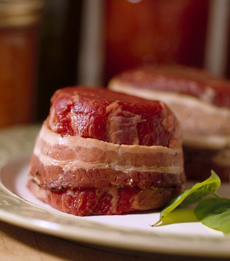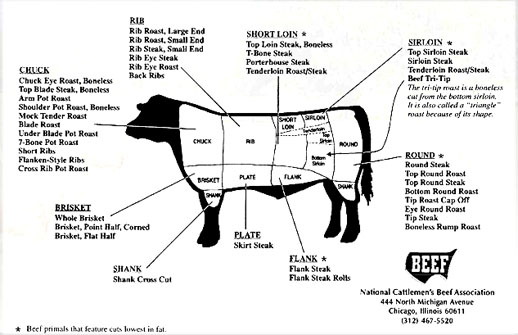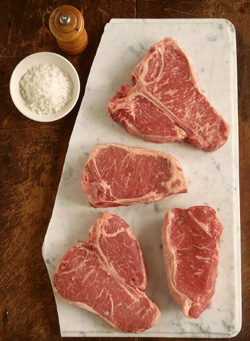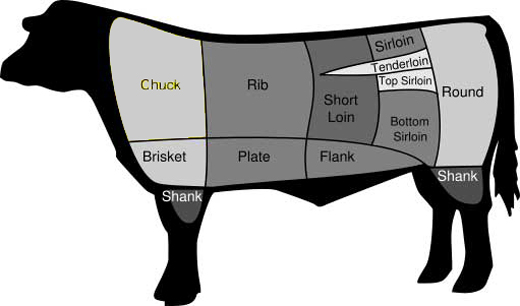Beef Glossary: A Glossary Of The Different Beef Types & Beef Cuts DiagramPage 5: Types Of Beef Terms & Definitions O To P This is Page 5 of an 8-page article. Click on the red links below to visit other pages. This glossary is protected by copyright and cannot be reproduced in whole or part. You are welcome to link to it.
|
 A Certified Angus® tenderloin, larded with a strip of bacon. Photo courtesy RockyMountainSteaks.com. |
|
|
If you’re looking for the definition of a particular cut of beef, you’ve come to the right place. Here’s the lingo butchers and other industry professionals use as they cut beef. (If you’d like to suggest additional words, click here.) On this page of the glossary, you’ll find terms such as aged beef, beef bacon, beef cheeks, beef jerky, beef stew meat, Black Angus beef and an answer to the question, What is beef? When looking up beef cuts, it’s helpful to refer to the beef cut diagram, courtesy of the National Cattleman’s Beef Association. If you enjoy this Beef Glossary, we have a food glossary for almost every category of food—including a Lamb Glossary and a Pork Glossary. 
Download your own beef cuts chart (pdf).
|
||
| ONGLET See hanger steak.
|
||
| ORGANIC BEEF Organic beef is very similar to natural beef, except that everything labeled “organic” adheres to strict USDA Organic program criteria and the ranch has been inspected and certified by an official organic certifier. There are numerous criteria, including no use of antibiotics (an ill animal that needs medicine is removed from an organic herd and generally moved to a natural herd) and there is no use of pesticides on any food eaten by the animals or on any hay it may sleep on. Many natural ranchers adhere to organic practices but elect not to undertake the time and expense of organic certification. WANT TO LEARN MORE ABOUT ORGANIC BEEF? THE NIBBLE TELLS ALL |
||
| OXTAIL Oxtail was once really from an ox, but today it is usually beef or veal tail. While quite bony and gelatinous meat, is very flavorful, and is popular in British and Caribbean cooking, in stews or soups. Oxtail requires long, slow braising.
|
||
| PALATABILITY The overall taste appeal (tenderness, juiciness and flavor) of cooked, lean beef.
|
||
| PASTURE-RAISED BEEF A term that is incorrectly used as synonymous with grass-fed beef. As defined by the American Grassfed Association (AGA), grassfed means “those food products from animals that have eaten nothing but their mother’s milk and fresh grass or grass-type hay from birth to harvest—all their lives.” If an animal is “pasture raised,” its food can be supplemented with grain (corn feed or a mix of cheaper grains)—i.e., not purely grass fed.
|
||
| PHILADELPHIA CUT See New York cut.
|
||
| PIEDMONTESE BEEF Also called Piemontese or razza bovina Piemontese, these white cattle originated in the Piedmont region, in northwest Italy. In Italy the Piedmontese (Piemontese in Italian) is a dual-purpose breed. The cattle are raised both for their milk, to make regional cheeses, and for premium, especially tender beef. A small number of cattle were imported into Canada and the United States in the late 1970s/early 1980s, and were used to develop a new breed of beef cattle known as North American Piedmontese cattle. The beef is sold as Certified Piedmontese®.
|
 A Piedmontese cow. Photo courtesy Piedmontese.com. |
|
| POT ROAST A pot roast is a less-expensive cut of meat, cooked slowly in a covered pot with water, and often root vegetables and potatoes, until it is moist and tender. While any type of meat can be cooked in this way (pork or veal, for example), it is most closely associated with beef. A beef brisket is often cooked as a “pot roast.”
|
||
| PORTERHOUSE or T-BONE STEAK The porterhouse is sometimes called the “king of all steaks” because it combines two top cuts of meat in one steak. On one side is a bone-in strip steak; the other side is a portion of tenderloin (filet mignon). The porterhouse is a larger T-bone steak, with more of the tenderloin and the strip steak.
|
||
| PRICE FLUCTUATIONS The price of beef is largely based on corn prices, the grain on which cattle feed in the latter days of their growth to develop the marbling. The degree of marbling is a major indicator of whether a piece of beef will be graded Prime or Choice. Ethanol uses up to 26% of the U.S. corn crop. As ethanol demand increases, the price of corn rises. As the price of corn rises, ranchers cut the number of days in which they feed cattle grain. There is less marbled meat, and thus a smaller supply of Prime and Choice meat.
|
 At top and bottom, two porterhouse or T-bone steaks, with two New York strip steaks in the middle. Note the heavy marbling in each: this is USDA Prime. Photo courtesy Morton’s The Steakhouse. |
|
| PRIMAL or WHOLESALE CUTS Basic major cuts that result from cutting carcasses and sides into smaller portions. The wholesale or primal cuts are the brisket/foreshank, chuck, flank, loin, round, short plate, short loin and sirloin. The primal cuts are further broken down into subprimal cuts. Examples of subprimal cuts of beef are the top round, whole tenderloin and rib eye.
PRIME
|
||
| PRIME RIB Prime rib refers to the finest beef, with even marbling and a creamy layer of fat. It must be USDA Prime, not USDA Choice. Only about 3% of the beef in America is graded USDA prime. Because of the scarcity, it is generally carried only by the finest butchers and restaurants. Often, rib roasts masquerade as prime rib in supermarkets, which typically carry USDA Choice (and lower grades—see all the grades of beef), not USDA Prime, meats. See rib roast.
|
 Prime rib. Photo courtesy Morton’s The Steakhouse. |
|
|
Go To Next Page, Terms Beginning With Q & R Go To Glossary Alphabet Index, Above |
||
Last Updated Apr 2018
© Copyright 2005-2024 Lifestyle Direct, Inc. All rights reserved. All images are copyrighted to their respective owners.
